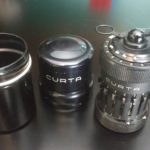Anyone who deals in collecting older computers, or heck even if you have just a few few nerd bits, has probably seen or heard about these calculators.
According to the Wikipedia article,
“The Curta was conceived by Curt Herzstark in the 1930s in Vienna, Austria. By 1938, he had filed a key patent, covering his complemented stepped drum, Deutsches Reichspatent (German National Patent) No. 747073. This single drum replaced the multiple drums, typically around 10 or so, of contemporary calculators, and it enabled not only addition, but subtraction through nines complement math, essentially subtracting by adding. The nines’ complement math breakthrough eliminated the significant mechanical complexity created when “borrowing” during subtraction. This drum would prove to be the key to the small, hand-held mechanical calculator the Curta would become.”

I’ve been hunting around for one of these for years, and I’m happy to say I finally acquired a Type 1 a week or two ago. This one is serial number 20120, manufactured in November, 1952 in Lichtenstein, where all Curtas were manufactured.
My unit functions perfectly, and I’m happily going through tutorials learning not only how to do basic math, but also more complex operations like roots and long division.
Yeah, technically it’s not following my rules for the vintage handheld collection, in that it’s not programmable in the way most folks consider, but in many ways it is a programmable handheld computer, with registers, a clock, and a limited ALU.